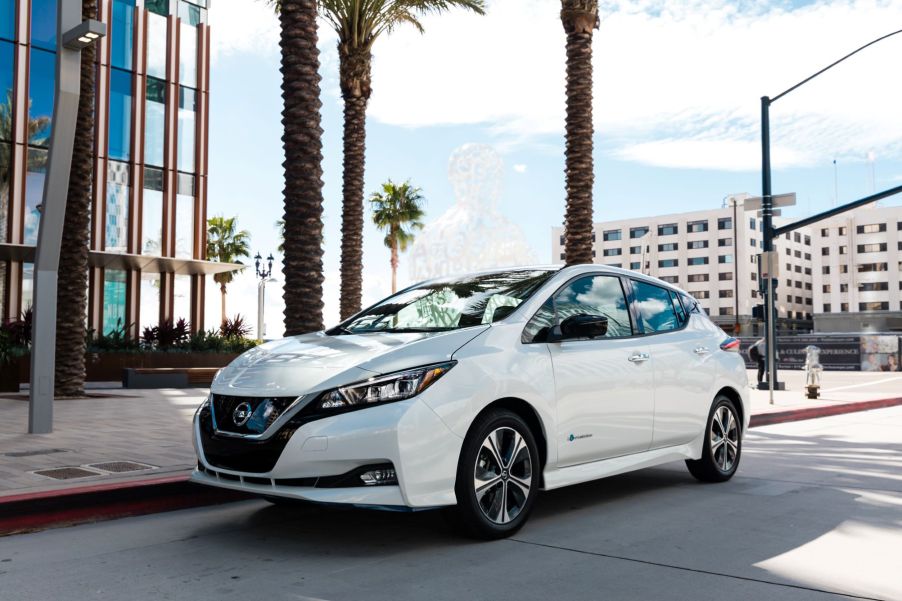
The 2019 Nissan Leaf Is 1 of the Best Used EVs You Can Buy
It wasn’t that long ago when there wasn’t much of a market for EVs, much less used ones. Yet today, you can offset or eliminate the higher upfront costs EVs typically sport by purchasing a used one. The used EV market is already well-established, so much so that you can now find used EV recommendations in many major automotive publications. So, if you’re looking for an EV hatchback, Consumer Reports thinks the 2019 Nissan Leaf is one of the best-used EVs to get.
Evaluating the best 3-year-old electric vehicles
If you’re looking for relatively new vehicles, Consumer Reports has you covered. Its recently published piece, “Used Cars: Best 3-Year-Old Electric Vehicles,” provides a great overview of recent models that you may be able to find on the market. If you’re familiar with Consumer Reports, the site uses a very complex evaluation system to painstakingly pore through survey data, review each vehicle thoroughly, and assess other available data from third parties to develop scores and recommendations.
The impetus for this article was the passage of the Inflation Reduction Act of 2022 by the Biden-Harris administration. This bill includes a provision for a $5,000 tax credit toward the purchase of a used EV. So, with the discount you usually enjoy when buying a used vehicle, plus this new $4,000 tax credit, you may never find a better time to buy a used EV than now.
Consumer Reports scoured its existing reviews and data to develop a list of the most reliable EVs from 2019. It also limited its choices to EVs with its proprietary Green Choice designation – a distinction bestowed upon vehicles with zero emissions. From these criteria, CR chose three EVs for you to consider. One of these is the often overshadowed Nissan Leaf.
Why the Nissan Leaf is one of the best used EVs you can buy

While the Nissan Leaf is not as flashy or buzzworthy as Tesla, it’s secured its place in the annals of EV history. It’s been around for quite some time and always enjoyed respectable reliability scores and reviews from Consumer Reports and others. The Leaf is in its second generation and sports some noticeable and praiseworthy improvements that make the 2019 model worth a serious look.
Available for between $23,575 and $30,625, the Leaf is certainly affordable. It also has a bigger battery than the first-generation model, which gives it 215 miles of range (compared to 150 miles for the first-gen model). It won’t win any awards for handling or maneuvering, but these aren’t deficits either. The Leaf does take 8 hours to charge fully (or 10.5 hours for the Leaf Plus). However, it does come with a home charging kit, making it easier to ensure you have a full battery.
Consumer Reports reviewers ding the Leaf a bit for the rear pillars that impede rear visibility, an awkward driving position, and unintuitive instrument panel controls. Still, praise was reserved for seat comfort and access, the optional ProPilot Assist system (which offers some automated driving features), and low cabin noise levels. If you can find one, opt for a Leaf Plus, which comes with an 8-inch touch screen (rather than the 5-inch one on the base model or the 7-inch one on the SV and SL trims.). The SV, SL, and Plus trims also have built-in navigation, satellite radio, and traffic service.
What other used EVs does Consumer Reports recommend?
Unsurprisingly, a Tesla also made Consumer Reports’ list. Specifically, the Tesla Model 3 is recommended, although, given its popularity, it might be hard to find one. You’ll also pay more for a Model 3 than a Nissan Leaf; Consumer Reports estimates one will cost you between $42,725 and $59,025. Still, if you can find one, you’ll get an impressive range – between 240 and 310 miles depending on the trim. You’ll also get a quiet cabin, solid performance and handling, partially automated driving, built-in navigation, and a 15-inch touchscreen.
The downsides? Reviewers noted that nearly all controls are handled through the touchscreen, which can be distracting. There are also Tesla’s well-known problems with its build quality, so you’ll want to inspect any used Tesla you may see before buying carefully. Additionally, there are also Tesla’s quirks, such as its unconventional door handles and steering yoke, to get used to. So, before buying one, it’s also best to acquaint yourself with Teslas and how they differ from most other vehicles.
If neither a Model 3 nor a Leaf suits your tastes, Consumer Reports recommends the Kia Niro Electric (or Kia Niro EV). You’ll find this hatchback handles well and comes with a generous heaping of amenities across trims. It can take 239 miles on a single charge and get you to 60 mph in 6.8 seconds. The interior earned praise for its upscale look, as did the number of standard advanced safety systems. Forward collision warning, automatic emergency braking, blind spot warning, and rear cross-traffic warning are found across trims and helped the Niro’s hybrid versions earn a Top Safety Pick+ award from the Insurance Institute for Highway Safety.
The tax credit sweetens the pot, but the available used EV options should be enticing enough for anyone to consider grabbing one. If you’re looking to switch from a gas-powered vehicle to an EV, looking for a newer vehicle, or buying a backup car, try to test drive a 2019 Model 3, Niro Electric, or Nissan Leaf as you make your decision.


